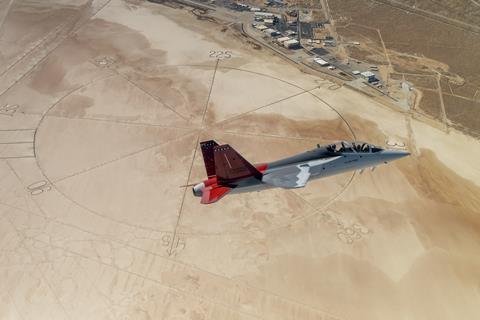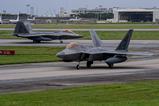The US Air Force (USAF) has pushed off a production decision for its new trainer jet until 2026.
A previous fielding schedule had called for the air force to reach a so-called Milestone C decision on the Boeing T-7A Red Hawk in 2025, formally approving the airframer to begin low-rate initial production of the single-engined jet.
Instead, the service will delay that decision until 2026, while purchasing four additional T-7A production-representative test vehicles (PRTVs) in fiscal year 2025 to supplement the current fleet of five test aircraft. Those jets are to be delivered to the air force in FY2026.
Air force acquisition chief Andrew Hunter on 15 January said the additional test capacity will allow the service to expedite some aspects of the T-7A flight-test programme, while narrowing a gap between assembly of the last test aircraft and the start of rate production.
“Decreasing overlap between development, testing and production lowers the likelihood of potential costly retrofits of a significant number of aircraft,” Hunter says.

The USAF ultimately plans to acquire 350 T-7As over 10 production lots to replace its current Northrop T-38C trainers. After some 60 years in service, those aged jets are now plagued by maintenance issues. The limitations are severe enough that the air force’s pilot training capacity has been affected.
The 2018 trainer replacement contract with Boeing was valued at some $9.2 billion.
Despite delaying the T-7A production decision until 2026, Hunter says the programme’s overall timeline remains intact, with receipt of Lot 1 aircraft and initial operational capability (IOC) planned for 2027. Earlier budget documents indicated the USAF plans to purchase seven jets under T-7A Lot 1 production.
Hunter notes that the additional test capacity provided by four more PRTV aircraft will allow the air force to accelerate the T-7A test plan and still achieve a timely IOC.
Boeing’s T-7 programme manager Evelyn Moore says the addition of four test aircraft ahead of rate production will help Boeing ensure its St Louis, Missouri assembly line is fully ready when the Milestone C decision comes.
“The agreement allows us to provide a production-ready configuration to the air force before low-rate initial production, further reducing any future risk to production,” Moore says.

The T-7A boasts a number of features that promise significant improvements to pilot training over the aged T-38. Its modern avionics offer a cockpit that is more representative of a fifth-generation fighter, while also being able to simulate the latest air combat radars – without the expense of installing such sensors on each jet.
Each Red Hawk will also be networked with a ground-based flight simulator system, allowing multiple aircraft and simulators to fly cooperatively or against each other in training scenarios.
Although the high-volume programme holds great promise for Boeing’s fighter unit, the T-7A has been a major source of financial pain for the company. Boeing won the contract using an aggressive fixed-price bidding strategy, which offered no recourse for cost increases and schedule delays generated by the Covid-19 pandemic.
The result has been penalty charges in the billions of dollars, driving steep losses at Boeing’s defence business. Boeing took $900 million in T-7A-related penalty charges in the third quarter of 2024 alone.
However, with an expected full-rate production capacity of 60 jets annually, Boeing remains bullish on prospects for the T-7A programme. The new trainer will help offset the winding down of F/A-18E/F Super Hornet production, which is expected to conclude in 2027.
Boeing is also now delivering its latest F-15EX strike fighter, of which the USAF plans to purchase around 100 examples. Funding provided by congressional lawmakers in the recent 2025 National Defense Authorization Act allots an extra $600 million to add six more jets to the air force’s F-15EX buy.
The company is also widely believed to be a finalist in the air force’s highly classified Next-Generation Air Dominance fighter development programme and a competitor for the US Navy’s F/A-XX sixth-generation fighter.































